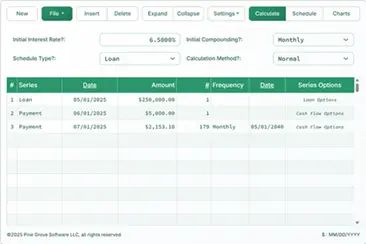How to Calculate a Loan with Scheduled Skipped Payments
To set your preferred currency and date format, click the “$ : MM/DD/YYYY” link in the lower right corner of any calculator.
A Step-by-Step Tutorial
Tutorial 12
“Skipped payment loans” are loans that have an irregular payment schedule. These payment skips are part of the loan agreement and are not considered missed payments. The Ultimate Financial Calculator can handle this type of loan structure.
Background: Some businesses borrow money at different times of the year to stabilize cash flow. Certain individuals may work seasonally and earn income only during specific months. For example, outdoor construction workers might not work in January or February. In such situations, borrowers may take out a loan that allows them to skip payments during months when income is lower or unavailable. This tutorial explains how to enter that type of loan setup.
Before using this tutorial, all users should review the more detailed first tutorial. It explains the basic concepts and settings of the UFC.
To create an amortization table that allows for skipped payments, follow these steps:
- Set Schedule Type to Loan.
- Alternatively, click to clear any previous entries.
- Click , then select . Set “Rounding” to Adjust last amount to reach “0” balance.
- In the header section, make the following settings:
- For Calculation Method, select Normal.
- Set Initial Compounding to Daily.
- Enter 8.75 for Initial Interest Rate.
- In row 1 of the cash‑flow input area, create a “Loan” series.
- Set the “Date” to February 15, 2024.
- Set the “Amount” to 75,000.00.
- Set “# Periods” to 1.
- Note: Since the number of periods is 1, you will not be able to set a frequency. If a frequency is set, it will be cleared when you leave the row.
- Move to the second row of the cash‑flow input area. Select “Payment” for the “Series”. Initially, the regular payment amount is unknown.
- Set the “Date” to March 15, 2024.
- Set the “Amount” to “Unknown”.
- Set “# Periods” to 48.
- This value defines the loan term as 48 months, including the skipped months.
- The actual number of payments will be fewer than 48.
- Because some months will have no payment, the calculated payment amount will be higher than if the loan were paid over 48 months with no skipped months.
- Before the calculation, your screen will look like this (Fig. 1):

- Display “Options for Selected Cash Flow Series” by clicking the second row’s right‑most cell in the “Series Options” column.
- Select the “Monthly Skip” tab at the top of the window.
- Make sure “Activate Monthly Skip series for the currently highlighted series” is selected.
- Set “Regular monthly amount” to “Unknown”.
- Set “Amount on skipped months” to $0.00.
- Skipped months are not required to have a zero payment, but this example uses $0.00.
- Check “July” and “August” as the skipped months. Fig. 2.
- Click .

- Click . The result is $2,232.10. Fig. 3.
- This is the required level payment amount when no payments are made in July or August.

- To view a detailed amortization schedule showing how the monthly payment is allocated between principal and interest, click . Fig. 4.
- Note: No payments are made in July or August, but interest still accrues during those months.

- Note: In addition to the “Monthly Skip” option, there is a “Series Skip” option.
- Series Skip is used with payment frequencies other than monthly. Fig. 5.
- The user specifies how many payments to make, followed by how many to skip.

Skipped payments can be a predefined feature agreed upon by both the borrower and the lender. Calculating the unknown payment amount for such a loan is complex. A financial calculator must handle the irregular cash flow and the interest that accrues during skipped periods. A correct result should require only a minimal rounding adjustment in the final payment. The Ultimate Financial Calculator is designed to perform this type of calculation accurately.
Back to the Ultimate Financial Calculator.
